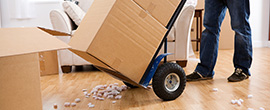Essential tips for safely moving your bed and mattress
Posted on 31/05/2025
Essential Tips for Safely Moving Your Bed and Mattress
Whether you're relocating across town or embarking on a cross-country move, safely moving your bed and mattress is crucial for protecting your investment and ensuring a comfortable night's sleep in your new home. Beds and mattresses are bulky, heavy, and often awkward to handle, increasing the risk of damage--not just to your bed, but also to floors, walls, and even yourself.
This comprehensive article will guide you through the best practices for securely moving your mattress and bed frame, ensuring both arrive in pristine condition. Read on for expert advice, actionable tips, and answers to commonly asked questions about transporting your bed and mattress safely.

Why Safe Mattress and Bed Moving Matters
A good bed and mattress can be a significant financial investment. Improper handling can result in:
- Tears and stains on the mattress fabric
- Broken or warped bed frames
- Personal injuries during lifting or carrying
- Damage to doors, floors, or walls
Utilizing safe moving practices not only protects your belongings but also streamlines the entire moving process.
Preparation: How to Get Your Bed and Mattress Ready
Planning ahead is key for a frictionless move. Follow these preparatory steps for bed and mattress relocation:
1. Gather Necessary Supplies
Before you start, collect the supplies needed to protect your bed and mattress:
- Mattress bag or heavy-duty plastic wrap
- Bubble wrap and moving blankets for bed frame parts
- Furniture dolly or hand truck
- Straps or rope for securing items during transport
- Tool kit for disassembly
- Ziploc bags to store hardware (bolts, screws)
- Markers and labels for organization
Tip: Mattress bags are available at most hardware or moving supply stores, offering excellent protection against dirt and moisture.
2. Clear a Path
Make sure the route from your bedroom to the moving truck is free of obstacles. Remove rugs, furniture, and sharp objects to prevent trips or snags as you maneuver large pieces.
3. Enlist Help
Never attempt to move a bed or mattress alone. Recruit friends or family, or hire professional movers. Mattresses can be awkward and heavy; having help reduces risk of injury and ensures furniture isn't damaged in the process.
Disassembling the Bed Frame
For most beds, disassembly makes moving much easier and safer. Here are the steps to break down your bed frame:
1. Remove Bedding and Mattress
- Take off all sheets, blankets, and pillows.
- Slide the mattress off the frame and set it aside, ready for wrapping.
2. Disassemble the Frame
- Refer to the manufacturer's instructions, if available.
- Carefully unscrew headboard, footboard, and side rails.
- Place all hardware in a clearly labeled Ziploc bag.
- Wrap wooden or metal pieces in moving blankets or bubble wrap to prevent scratches and dents.
Note: For platform or adjustable beds, take special care with electrical components--consult your manual before unplugging or detaching any wires.
3. Keep Parts Together
- Store screws and bolts in a bag taped to the headboard or another large piece.
- Label each bed component; this helps with streamlined reassembly in your new home.
Packing Your Mattress for Safe Moving
Mattresses can attract dust, dirt, and mold during transit and are prone to tears. Here's how to keep yours protected:
1. Use a Mattress Bag
- Slide the mattress into a dedicated mattress bag for a secure fit.
- Tape or seal the ends to protect from moisture and bugs.
2. If You Don't Have a Mattress Bag
- Wrap the mattress tightly in plastic wrap or several layers of clean blankets.
- Secure with packing tape, but avoid sticking tape directly to the mattress fabric.
3. Move the Mattress Carefully
- Do not bend or fold most mattresses except for those specifically designed to do so (such as certain memory foam models).
- Keep the mattress upright when moving through hallways.
- Use a dolly for larger, heavier mattresses.
Tip: Mattresses with inner springs or hybrid construction can be damaged when bent--handle them with extra caution.
Safely Moving and Loading Your Bed and Mattress
1. Lifting Techniques
- Bend your knees, not your waist, when lifting heavy or bulky items.
- Lift with your legs, keeping the item close to your body.
- Use team lifting for queen, king, or specialty beds to evenly distribute weight.
This helps prevent back injuries and supports even, stable handling.
2. Navigating Hallways and Stairs
- Walk slowly, communicate with your moving partner, and watch for tight corners.
- Use mattress straps or carrying handles (if available) for better grip.
- Take a break at landings during stair moves; never rush or overexert yourself.
3. Loading Into the Moving Truck
- Lay the mattress flat on top of other furniture if there's room; avoid placing heavy boxes on top of it.
- If space is limited, transport the mattress upright, secured with straps to prevent shifting.
- Stack and secure bed frame pieces, and place headboard/footboard on end to conserve space.
Special Considerations: Moving Specialty Beds and Mattresses
Not all beds and mattresses are created equal--here's how to move special types:
Memory Foam and Latex Mattresses
- These are heavier and more pliable--always move with at least two people.
- Avoid excessive bending; too much flex can damage the foam layers.
Adjustable Beds
- Disconnect and pack electrical cords separately.
- Secure mechanical parts with moving blankets and zip ties to minimize shifting during transport.
- Consult the manufacturer for guidance if unsure.
Antique or Delicate Beds
- Handle wood with gloves to avoid oil transfer.
- Cushion intricate carvings or fragile areas with extra bubble wrap.
Unpacking and Reassembling in Your New Home
Once you've arrived, follow these steps for a smooth bed and mattress reassembly:
1. Inspect for Damage
- Check all frame parts for cracks, warping, or missing hardware.
- Remove the mattress bag and air out your mattress before making the bed.
2. Reassemble the Frame
- Lay out all components and hardware for easy access.
- Follow your labeled instructions or photos from disassembly.
- Tighten bolts securely, but avoid overtightening which can strip threads.
3. Set Up Your Mattress
- Place the mattress on the reassembled frame and ensure it sits securely.
- Allow the mattress a few hours to return to its normal shape if compressed during the move.
Tip: Now's a great time to vacuum the bed frame and mattress surface before making the bed.
Expert Moving Tips and Common Mistakes to Avoid
Here are some additional do's and don'ts to ensure your bed and mattress move safely:
Do:
- Label hardware and bed parts during disassembly
- Use proper packing materials to protect surfaces
- Lift with care and always have help on hand
- Check the truck space in advance for mattress fit
- Consider professional movers for very heavy or complex beds
Don't:
- Drag mattresses or bed frames--this can tear fabric and scuff floors
- Use tape directly on mattress or wood finishes
- Leave beds and mattresses exposed to rain or extreme weather
- Let the mattress rest on its side for long periods (except when unavoidable during brief transit!)

Frequently Asked Questions: Bed and Mattress Moving
-
Can I move a mattress on the roof of my car?
While it may seem convenient, this is generally unsafe and not recommended. Most mattresses are too large and unwieldy. Always use a proper moving vehicle for best results. -
What if my mattress gets wet during the move?
Remove any wet coverings as soon as possible. Use fans or a dehumidifier to help it dry quickly and prevent mold growth. -
How do I move a king-size or California king bed?
Follow the same steps, but ensure you have extra hands. It may also help to take more photos during disassembly for easier reassembly. -
Is it worth hiring professionals to move my bed and mattress?
If your bed is exceptionally large, valuable, or you have limited help or mobility, professional movers are well worth the investment for safety and peace of mind.
Conclusion: Move Your Bed and Mattress Safely, Sleep Soundly
Relocating your bed and mattress doesn't have to be stressful or risky. With careful planning, the right supplies, and the help of friends (or professionals), you can safeguard your sleep comfort and avoid unnecessary damages or injuries. Remember these key guidelines:
- Always disassemble the bed frame and use mattress covers
- Label, bag, and keep hardware organized
- Use safe lifting techniques and a clear moving path
- Secure all components inside your moving vehicle
Whether you're moving across the street or to a new city, these essential tips for safely moving your bed and mattress will help make sure your most important furniture arrives ready for perfect rest on your very first night in your new place!










